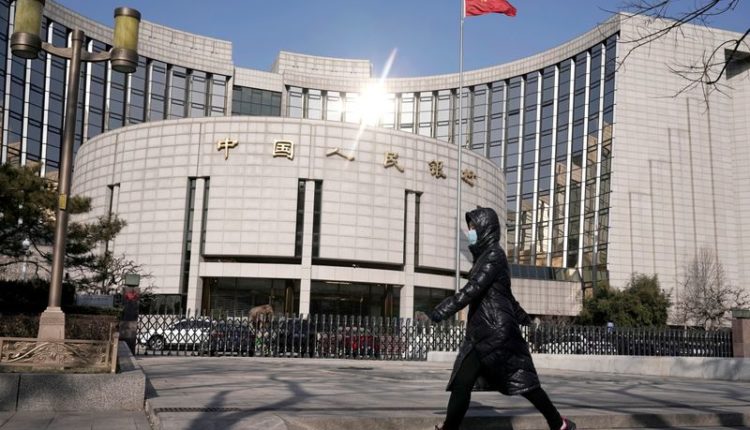Exclusive: China’s central bank to step up easing, won’t borrow Fed playbook – sources
By Kevin Yao
BEIJING (Reuters) – China’s central bank will ramp up its policy easing to support the coronavirus-ravaged economy but debt worries and property risks will prevent it from following the U.S. Federal Reserve’s steep rate cuts or quantitative easing moves, policy sources said.
China’s leaders have pledged to combat the impact from the pandemic that looks to have tipped the world’s second-largest economy into its first quarterly contraction in at least 30 years, as mounting job losses pose a threat to social stability.
The People’s Bank of China (PBOC) will boost credit and lower funding costs, especially for small firms seen as vital for growth and jobs, and accommodate increased fiscal spending, according to three sources involved in internal policy discussions. The sources declined to be named due to the sensitivity of the matter.
The PBOC said on Friday it was cutting reserve requirement ratio (RRR) – the amount of cash that banks must hold as reserves – for the third time this year, and lowered interest rate on banks’ excess reserves for the first time since 2008.
The central bank will largely rely on a mix of liquidity policy tools to support the economy, such as RRR and various lending facilities, and price-based tools including various market rates and its benchmark lending rate – the loan prime rate (LPR), the sources said.
“The PBOC will step up monetary policy easing, but it’s impossible for it to follow the Federal Reserve,” said one of the sources. “The PBOC will take a step by step approach and reserve some ammunition.”
The PBOC and the finance ministry did not immediately respond to Reuters’ requests for comment.
The Fed slashed interest rates by a half percentage point on March 3 and by a full point was on March 15, bringing the Fed’s overnight borrowing rate for banks back to near zero, and restarted a quantitative easing programme.
In recent years the PBOC, which uses multiple tools to control interest rates and money supply, has been trying to develop a single representative policy rate like the Fed’s funds rate.
The PBOC is likely to cut the LPR on April 20, following a 20 basis point cut in the 7-day reverse repo rate on March 30, and trim the benchmark deposit rate in the coming months as consumer inflation is expected to ease, the sources said.
The central bank has cut the LPR, which is set on the 20th of each month, by a total of 26 basis points since August – when it unveiled a key reform to use the LPR to replace the previous benchmark lending rate. The one-year LPR rate is currently at 4.05%.
A deposit rate cut could help ease pressure on lenders and create more room for lowering lending rates, but such a move could be politically sensitive, given that real deposit rates are already deep in negative territory, the sources said.
The PBOC has kept the benchmark deposit rate unchanged at 1.5% since October 2015. Consumer inflation was 5.2% in February.
Vice PBOC governor Liu Guoqiang said last week that China would tread warily in cutting the benchmark deposit rate due to elevated inflation and the potential impact on ordinary savers.
“We should continue to cut RRR and interest rates. But we should be worried about the side-effects if monetary policy easing becomes too strong, as we are still digesting the hangover from previous stimulus measures,” said a second source.
“If more money flows into the property sector, it would fuel property speculation and lead to social problems.”
Since 2016 Beijing has stepped up its de-leveraging campaign, but last year in its annual report the PBOC warned that financial risks “are still abundant, after accumulating rapidly in the past few years.”
Since early February, the central bank has unveiled a raft of measures from cutting lending rates and making cheap loans at subsidized rates to providing payment relief to firms that have been hardest hit by the outbreak and virus containment measures.
Yet, the PBOC’s current easing has been more measured than during the global financial crisis, when it slashed its key lending rate by a massive 216 basis points in late 2008.
LEANING ON FISCAL STIMULUS
In the past month global policymakers have unveiled a burst of unprecedented stimulus to combat the coronavirus and prevent a deep worldwide recession. Leaders of the G20 have also pledged to inject over $5 trillion into the global economy to limit job and income losses from the pandemic, which has so far infected nearly 1.4 million people and killed more than 80,000 in over 200 countries.
Chinese leaders, who have acknowledged the constraints on monetary policy, will lean on fiscal stimulus to spur infrastructure investment and consumption, the sources said.
“Fiscal policy will play the main role (in supporting the economy), and monetary policy will actively cooperate with fiscal policy,” said another source.
Lower interest rates will support the government’s spending plans and more fund injections from the central bank will help banks and firms buy government debt, the sources said.
Beijing, mindful of the lessons learned in 2008-09 when a massive stimulus package saddled the economy with a mountain of debt, will make sure investment projects are more financially sound, the sources said.
Policy sources have told Reuters that the Chinese government could expand the 2020 budget deficit to a record high. A central bank adviser has suggested that a growth target not even be set this year due to the uncertainty.
But the sources said top leaders still want to set a growth target, albeit lower than the initially agreed goal of around 6%, ahead of the annual parliament meeting, which was originally scheduled for March 5 but was postponed due to the outbreak.

